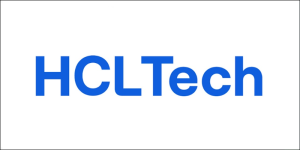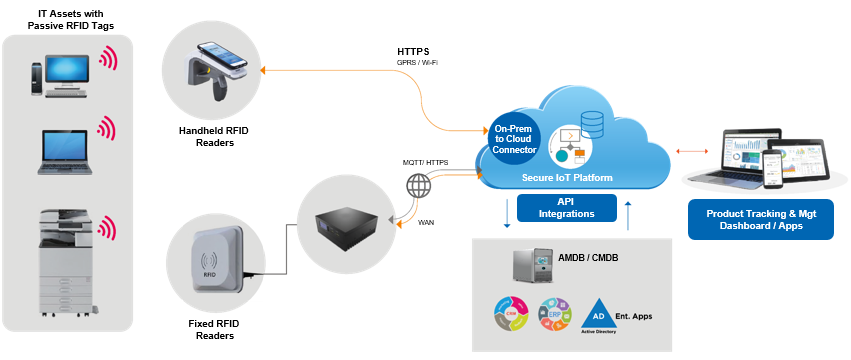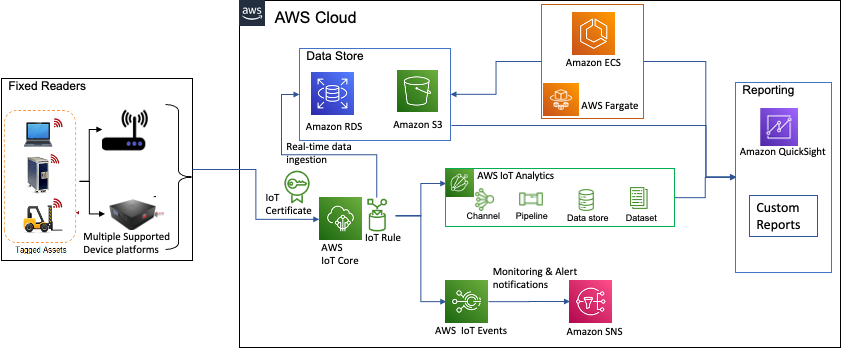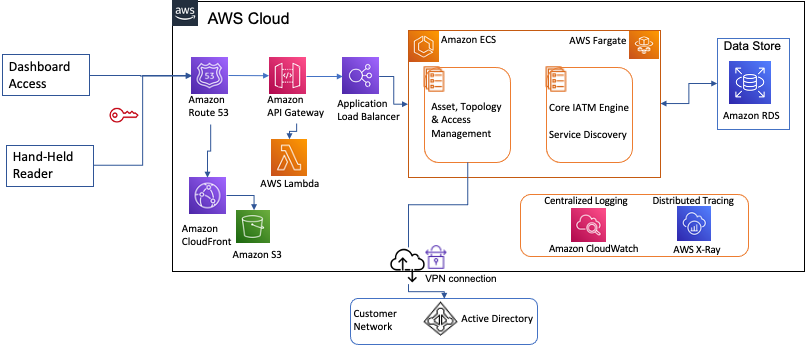AWS Partner Network (APN) Blog
Transforming the Asset Value Chain Through Smart Digitization Using HCL IATM and AWS IoT
By Mayank Mathur, Sr. Solutions Architect, IoT WoRKS – HCLTech
By Navneet Tripathi, Solutions Architect, IoT WoRKS – HCLTech
By Madhumanti Banerjee, Technical Product Manager, IoT WoRKS – HCLTech
By Rishi Sharma, Sr. Partner Solutions Architect – AWS
 |
| HCLTT |
 |
Enterprises and businesses across industries need to track inventory and assets in real time. This helps them to improve operations efficiency and productivity, eliminate potential losses, and have end-to-end visibility of industrial operations.
Inventory tracking focuses on understanding the items that a business manufactures or sells and is generally tracked for the short duration, whereas asset tracking primarily focuses on items an enterprise owns and uses repeatedly.
Asset tracking examples vary by industry and can include assets like laptops, warehouse lifts, construction equipment, airport vehicles, medical equipment in hospitals, or even the workforce in some scenarios.
Advancements in Internet of Things (IoT) supporting technologies, communications, and miniaturization have expanded the range of asset tracking to multiple industries and various asset types.
As the number of assets deployed across multiple geographies increases, the role of IoT and cloud computing becomes more prominent—from managing devices and performing analytics to extracting valuable and actionable insights.
Enterprises seek to have seamless experience for:
- Asset onboarding over various technologies (for example, RFID, BLE, Wi-Fi, and LoRa).
- Lifecycle management, audits, and reconciliation.
- Data ingestion from multiple sources such as RFID readers, BLE and LoRa gateways, Wi-Fi devices, and GPS.
- Data analytics, reporting, and unified governance.
In this post, we’ll walk you through how HCLTech’s Intelligent Asset Tracking & Management (IATM) solution helps enterprises improve operations efficiency and productivity by providing asset tracking capabilities over multiple technologies.
IATM by HCL IoT WoRKS is a solution that aims to digitally transform asset inventory management processes and improve asset visibility through proactive notifications and alerts to the asset manager. The plug-and-play design integrates with the existing enterprise systems and harnesses the power of IoT throughout the asset lifecycle.
HCLTech is an AWS Premier Tier Services Partner and Managed Service Provider (MSP). HCL IoT WoRKS is a dedicated business unit helping organizations at different adoption levels of IoT solutions with its define, build, and run framework.
Evolution of IATM
Amazon Web Services (AWS) offers a broad and deep set of services supporting each layer from the edge to the cloud.
AWS IoT offers a managed cloud service that can ingest trillions of messages from billions of devices. AWS IoT integrates with other AWS services, which helps organizations build complete solutions like IATM for a wide range of use cases, from industrial and commercial to connected homes.
The IATM solution evolved from an RFID-based solution to track assets and manage inventory for end user computing (EUC) devices at an enterprise level.
These businesses had the need to streamline the process of managing devices and improvise on the visibility of the inventory, thereby improving accuracy of their central repository of asset management database. The repercussions of reduced asset visibility have direct financial impact.
IATM continued to evolve with a goal to provide IoT and Industrial Internet of Things (IIoT)-based scalable solutions capable of handling customer requirements on a global scale, and bring in support for various technologies like Wi-Fi, BLE, and GPS. This provides flexibility to customers with diverse physical layer connectivity and tracking requirements.
Figure 1 – Overview of data and control from physical to visualization layers in the IATM solution.
IATM on AWS can help enterprises across industry verticals like manufacturing, industrial machinery, financial servers, transportation and logistics, power and utilities, oil and gas, and life sciences.
The robustness and applicability come from the flexibility of tracking technologies supported by IATM, and the secure and scalable services offered by AWS.
IATM: Applications Across Industries
Organizations of all sizes and across industries realize the importance of asset tracking to gain visibility of their assets for better utilization and to reduce losses. For example, customers in the healthcare industry deal with a large volume of equipment for treatment of patients. Customers in the energy and utilities industry, meanwhile, must maintain a fleet of field vehicles containing grid-maintenance equipment.
IATM application architecture is based on a modular design pattern that provides customers with flexibility to implement an asset tracking solution that fits the requirements of their industry and asset types.
The following figure provides a list of IATM implementations by industry.
Figure 2 – Overview of industry-specific solutions.
IATM: IT Asset Tracking
The IT asset tracking solution is an RFID-based solution for End User Computing and non-EUC devices like laptops, printers, and screens.
As part of onboarding the assets, RFID tags are attached to each device. The fixed readers track the movement of assets and publish location data to the AWS Cloud using AWS IoT Core. The IATM portal in-turn reflects the information for each device in real time.
Meanwhile, the Handheld Terminal (HHT) is used for asset onboarding, search, auditing, and deboarding. All of the relevant information is updated on the IATM portal through an HTTP secure channel.
Figure 3 – Asset tracking from HHT or through a gateway.
In addition to RFID-based asset tracking, IT assets like laptops, desktops, and tablets can be configured with soft tagging. A soft tag is a virtual tag, which runs on each device as a lightweight program and provides information related to the IATM platform.
The following diagram provides an overview of IT asset tracking using soft tagging.
Figure 4 – Soft tagging of IT assets.
IATM for IT assets provides an end-to-end workflow to track asset inventory across the entire lifecycle from onboarding to de-boarding. Four main areas in the IT asset tracking lifecycle are as follows:
- Asset tagging, onboarding, and inventory updates.
- Allocation to users, managing returns, maintaining state, and stock information.
- Audit and reconciliation processes.
- Real-time tracking of movement of assets.
With the entire process in place, the IATM solution running on AWS acts as an enhancer for the gateway and sensors.
IATM: Smart Warehouse Solution
Acting on its product roadmap, HCLTech has introduced a new product variant to IATM in the warehouse space called IATM: Smart Warehouse.
This product aims to improvise the key challenges faced by warehouses in tracking inventory visibility, optimizing current warehouse processes (both inbound and outbound), and reducing safety incidents by tracking Material Handling Equipment (MHE) inside warehouse premises.
In the process, IATM has been integrated with SAP Extended Warehouse Management (EWM)—one of the leading warehouse management systems across industries. This variant will demonstrate IATM’s capability to use tracking technologies other than RFID as well as Bluetooth Low Energy (BLE).
Figure 5 – Smart Warehouse solution overview.
BLE-based tracking plays an important role in use cases like forklift location and utilization tracking, and collision avoidance (man-machine and machine-machine).
Figure 6 – BLE-based tracking for moving equipment.
Solution Architecture: IATM on AWS
The HCL IoT WoRKS team chose a microservices-based architecture over a monolithic design for the IATM platform. Microservices enable customers to take a more active role in defining service boundaries.
Another advantage is to have technology heterogeneity, which provides flexibility to select the right tool or service for the job rather than having a more standardized approach.
IATM’s adaptive design gives customers flexibility to deploy the solution without the need to change the existing set of asset tracking technologies deployed. IATM seamlessly integrates and ingests data from third-party products over multiple supported channels.
With a goal to provide customers a solution that has minimum operational overhead and higher levels of availability and reliability, the entire IATM application architecture is based on fully managed AWS services.
IATM uses services like AWS Lambda for event-driven components, Amazon ECS on AWS Fargate for containers, Amazon Relational Database Service (Amazon RDS) for database, and Amazon MQ for seamless integration with third-party RFID reader platforms. This helps customers focus on business operations, while AWS does the heavy lifting of managing the underlying infrastructure.
Agility is an important feature that enterprises seek in an asset tracking solution, mainly to ensure the latest tracking technologies can be integrated with minimum overhead into the existing platform.
IATM achieves this by abstracting a Device Layer from the Core System Layer:
- Device Layer provides flexibility to integrate various asset tracking technologies and third-party solutions.
- Core System Layer is based on modular and microservices architecture, and seamlessly integrates with the Device Layer and ingests data in multiple supported formats.
Device Layer Abstraction in IATM
Fixed Readers: IATM can directly ingest data from devices or device gateways which can communicate over standard protocols like HTTPS or MQTT.
IATM uses AWS IoT Core, a completely managed service, to route data based on IoT rules. AWS IoT Analytics is a fully-managed service that makes it easier to run and operationalize sophisticated analytics on massive volumes of IoT data.
Figure 7 – IATM with fixed readers uses AWS IoT Core to ingest data at any scale.
Third-Party Solutions: Reader systems using industry-standard APIs and protocols for messaging, including JMS, NMS, AMQP 1.0 and 0.9.1, STOMP, MQTT, and WebSocket, can be integrated seamlessly by using Amazon MQ.
Figure 8 – Ingesting data from third-party reader systems using Amazon MQ.
Handheld Readers and Devices: Requests from handheld or mobile readers and user sessions get routed by Amazon Route 53. Meanwhile, Amazon API Gateway and Application Load Balancer handle the requests and route to the required service endpoints hosted using Lambda, or to containerized core application running on Amazon ECS.
Figure 9 – Handheld readers and web user traffic in IATM handled by AWS services.
IATM Core System Layer
The IATM core system architecture uses fully managed AWS services to implement complete serverless architecture. The IATM application core engine is a containers-based microservice and runs on AWS Fargate with Amazon ECS, with the database hosted on Amazon RDS.
User sessions and API endpoints are handled using Amazon API Gateway and Application Load Balancer.
Figure 10 – IATM Core System Layer.
Security is a key focus area for solutions like IATM, where data ingestion is from multiple sources. The AWS Shared Responsibility Model provides the advantage and flexibility to implement a strong security framework.
IATM uses AWS services like AWS Identity and Access Management (IAM), AWS Certificate Manager, and AWS security groups to ensure security at all layers.
Tying it All Together
There are customer scenarios where asset tracking requires the use of multiple mechanisms. This includes fixed readers, third-party device readers, and handheld devices.
IATM’s modular and scalable design lets customers integrate and support all such mechanisms. IATM ingests data from these sources and provides customers a single platform to track and manage assets.
Figure 11 – IATM implementation supporting tracking technologies as a single platform.
IATM’s modular design helps customize the deployment of solutions for customers based on their requirements and asset tracking technologies. Combined with Amazon’s pay-as-you-go approach for services on AWS, IATM is cost effective, scalable, and flexible.
How Business Drives Benefits
When organized into meaningful insights, data brings real value to the owner of the data. The handshaking of collected data, backed up by smart sensors, with an ability to process and analyze it on the cloud, adds to the robustness of IoT solutions. This enables the “run-anywhere” and “access-everywhere” intelligence of an IoT product.
Real-time tracking and timely business decisions can lead to reduction in operational costs. With a boost in speed of tracking assets, business fraudulence risks come down and improve operational efficiency on the whole.
Summary
In this post, we showed you how the HCLTech’s Intelligent Asset Tracking and Management (IATM) solution delivers value for customers.
IATM provides enterprises an omni-tracking platform meant to track varied asset categories by using different tracking technologies, such as RFID, BLE, GPS, and NB-IoT.
HCL IoT WoRKS strives for scalability, flexibility, reliability, and security in developing solutions while reducing costs and maintaining the quality of the solution or services.
The content and opinions in this blog are those of the third-party author and AWS is not responsible for the content or accuracy of this post.
HCLTech – AWS Partner Spotlight
HCLTech is an AWS Premier Tier Services Partner and MSP. With a dedicated cloud-native business unit, HCLTech builds and provides enterprise cloud computing solutions on the AWS platform.











